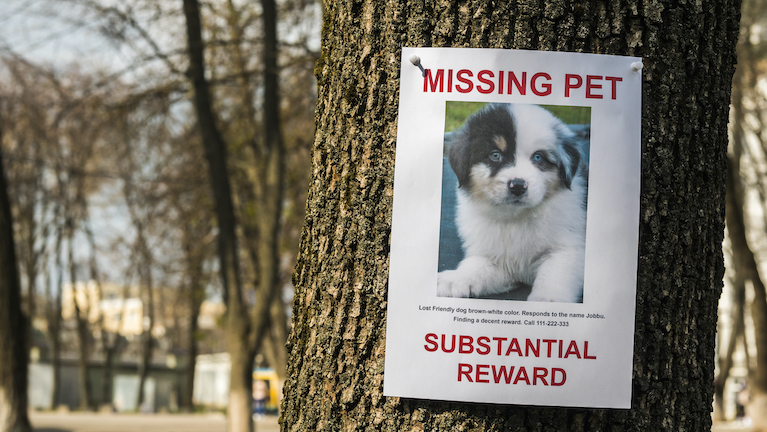
Domestic Disaster: What to do if your pet goes missing
Could a short term loan from Loans 2 Go help to find your pet?
As we all know, domestic disasters can strike at any time. It’s something that we don’t really like to think about. In fact we can be scared to think about it, in case somehow that might make things actually start to go wrong.
But it’s far better to be prepared for things that could happen, even though hopefully they never will.
So at Loans 2 Go we run an occasional series called Domestic Disasters. These articles contain helpful advice about what to do if bad things happen to your home. Our past articles have covered:
In today’s article we look at what to do if your pet goes missing.
Be prepared in advance
If your pet goes missing for any reason, it is heartbreaking and stressful. You will need to act as quickly as possible, so the last thing you want to be doing is scrambling around looking for the vital information that you need to help you.
So we recommend that as soon as you finish reading this article, you take an hour straightaway to organise all the following. Just one hour’s effort will give you peace of mind and could save you precious time in a pet emergency.
We hope that you never have to use most of the items on the list below, but better to be safe than sorry:
-
Make a list of people to contact in the event of your pet going missing
If your pet goes missing, you need to know who to contact for help. So make that list now, and save the numbers in your phone.
You need to include:
-
Ensure the microchip database has your up to date details
By law, every dog in the UK must now be microchipped by the time they are 8 weeks old. The Gov UK website has details of the various microchip databases, and where to get your pet chipped.
Cats do not legally have to be microchipped, unless they are travelling under the Pet Travel Scheme. But organisations such as the Cats Protection League recommend microchipping for cats, as a safe and permanent way to give a lost cat the best chance of being returned to their home.
Remember that as well as knowing the contact details of your pet’s microchip database, it is essential that you also keep them up to date with your details. So if you have moved home, or changed phone numbers, they need to have this information. This will avoid any delay in them contacting you if your lost pet is found.
If your pet is not insured then it is definitely worth considering this. Insuring a pet costs money, but you can then claim money back for vets bills and medication. Many insurance policies also cover some of the costs of a pet going missing, for example the cost of printing posters and paying a reward.
If you do not have insurance, you need to decide how much money you are prepared to spend to try and find your pet. If necessary, you may need to consider taking a short term loan just to boost your funds in order to get him or her home as soon as possible.
-
Put together an up to date set of photos of your pet
If your pet goes missing, you will need photos for posters, leaflets and social media. So sort out a few good recent photos now, and keep both printed and digital versions where they would be easy for you to find in the event of your pet going missing.
-
Draft a leaflet that you could use if your pet went missing
It may also be worth preparing a draft leaflet that you could use if your pet did go missing. You would need to add some last minute details – such as date and place last seen – but a lot of it could be prepared in advance. It may feel silly doing it now, but would you really want to be fiddling around creating something from scratch on the computer if you were worried sick about your pet?
-
Keep all your pet documentation together
It can be really helpful to have all your pet’s documentation at the ready just in case you get asked to prove ownership of your pet when he or she is found. So make sure you can lay your hands on your registration documents, purchase receipts, vaccination certificates, insurance certificates, microchip numbers, vet bills etc. Anything you have to provide information about the pet and prove that he/she is yours.
-
Make sure your pet has a collar
By law, dogs must wear a collar when in a public place. The collar must have a tag with your name and address. Again, it is important to ensure that these details are up to date.
Cats do not have to wear collars and tags, but many cat owners feel safer if they do. It’s possible to buy quick release collars for cats which will pull apart if the collar gets stuck on anything.
Some pet owners also invest in GPS collars that include a tracking device. Whilst these won’t stop your pet going missing, they can be invaluable in helping to trace a missing pet.
What to do if your pet goes missing
When you have done all the above, you will be in a strong position if the worst happens and your pet does go missing.
If your pet does go missing you need to:
-
Contact everyone on the above list
You will then be reassured that all the relevant authorities and support groups are aware that your pet is missing and have all his/her details. Make sure that they have the correct contact details for you, and if possible a back up contact in case you are not available.
-
Publicise details on social media
You have pictures at the ready, and just need to add details of where and when your pet was last seen. But be wise about the amount of personal information you share about you or your pet. The idea is to get your posts shared as widely as possible, but make sure you are not opening yourself up to either hoax calls or trolling.
-
Distribute leaflets in the area
These can be displayed on notice boards, in shop windows, at vets and pet shops, on trees and lamp posts, and pushed through doors. Also give them to locals who are out and about a lot, such as dog walkers, postmen/women, and window cleaners. You may want to offer a reward but, as with social media, be careful about how much information you give about this or about yourself or your pet. You want enough information to enable people to identify your pet and get in touch with you, but also guard your privacy and protect yourself against hoaxes or scams.
First of all thoroughly check the area where your pet was last seen. If your dog has gone missing on a walk, he/she may have been able to make their way either to your car or to any social area such as a cafe or shop.
The next thing to do is to walk round the area where your pet was last seen, calling their name. If they were last seen near home, try calling them from between there and your home, to encourage them to follow the sound of your voice and head back in the right direction. Make sure you wait and listen carefully in between calling, in case your pet is trapped or injured and is trying to respond.
Also pay attention to any empty properties nearby, for example vacant homes or homes where the owners are away. Cats in particular can get into the most unusual places then hide and get locked inside.
Lost cats are very receptive to scent, so try leaving scented items outside such as used cat litter, unwashed clothing, or vacuum contents which may attract the cat’s attention if he or she is in the vicinity.
You can also get professional advice and help with your search from Animal Search UK.
What to do if your pet is stolen
As well as doing all of the above, if your pet has been stolen you also need to report the theft to the police as soon as possible. They will give you a Crime Reference Number that will enable you to track whether they have any news about your pet.
It is also worth checking whether any businesses or homes have CCTV that may have been operating in the area when your pet disappeared.
In the case of a stolen pet, social media can be particularly valuable in terms of sharing details of the theft and making your pet too hot to handle.
We hope that you never need to use the above advice and information. But if you are unfortunate enough to have a pet go missing or get stolen, we hope that it will help you to be reunited with your furry friend as soon as possible.
Check back here soon for more lifestyle and financial tips from Loans 2 Go.


 Now is the time to start planning your financial goals for 2026
Now is the time to start planning your financial goals for 2026 
















